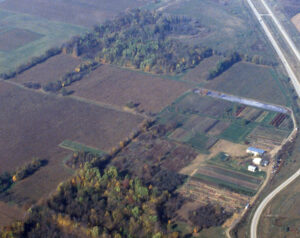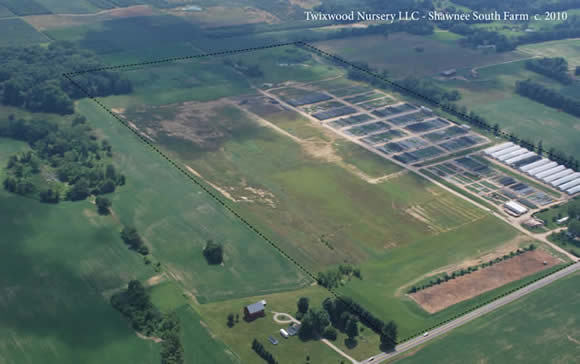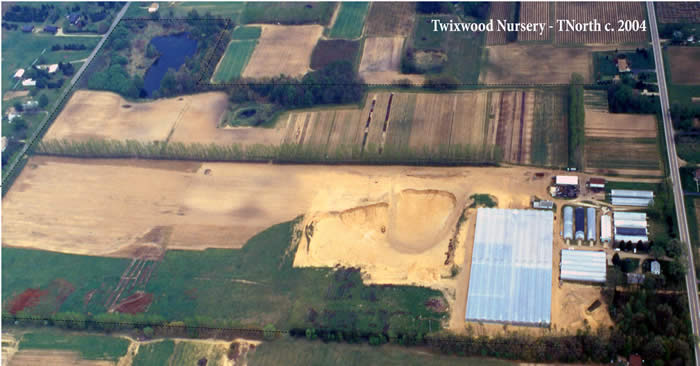Here are some aerial photos of our five locations. The purpose of all of this is to give our customer base some idea of our size and competency; the downside being that it reminds my wife of our size and complexity. The combination of those two attributes will indicate what kind of product we will be able to produce. The nursery locations will be listed in chronological order, so some history will creep in. You will note that we did not go for originality when naming these locations. Most are named after the closest road.
Therefore, we have five locations, one million square feet of poly space, 360 acres, 60 acres of field growing area, and natural gas at all five of the locations with poly houses. About a third of our container area is outside and unprotected, something we can get by with most of the time because of lake-effect milder winter temperatures and lake-effect snow cover. No one told us how the nursery business was going to develop in the last 36 years or we would have planned differently (better). While looking through this presentation please keep in mind what my wife says: “Having five locations and getting this large is not a sign of intelligence.” What I say is: “Our Golden years are dependent on the success of this operation.”
~Tom Kimmel
Locations

Hillcrest
This is the original location where the nursery was started by my parents in the spring of 1968. It is 33 acres left from the original 80 acre fruit and vegetable farm that my parents worked on all of their life before subdividing 47 acres of it. The St. Joe River is in the distance and the nursery has 7 acres of flood plain along its bank. The first three offices were on this location as it grew rapidly in the early years. We have rented from our neighbor 16 acres of good sandy loam for perennial production. The rental has been for over 30 years although by now much of that acreage has been planted into trees and shrubs and so it is non-producing.

Shawnee North
This location has 24 acres and is five miles from the home nursery. It is our first new land. We acquired it because we calculated that we would need only 5 acres to expand the nursery to its ultimate and ideal size. We started out with 28′ x 100′ cold frames for pachysandra production. Then we put in a loading dock and then a two story office building and then filled it completely up with poly houses and pachysandra stock beds and then we ran out of room again.

Snow Road
This is 120 acres of woods and grapes and 16 acres of field growing. The soil is heavy clay that has been amended with mushroom compost. There are no poly houses here. The production is hemerocallis, ornamental grasses, red and yellow twig dogwood for winter decorations, and boxwoods—the three Sheridan Hybrids. This location is a little over a mile from the Shawnee Farm.

Shawnee South
After acquiring the Snow Farm the farmer across Shawnee Road from our office offered to sell us his 95 acre farm that was mostly cherries. It was rolling hills and so we moved 100,000 yards of material to get 32 acres of flat slightly sloped ground. We have put cold frames and container yards on this property. We also have 12 32′ x 200′ natural gas heated poly houses placed on a corner of the property before we began the levelling process. In the back corner we have 5 acres for field perennial production. That soil has been amended by years of dumping of old container soil, so it is highly organic and very rich. That is being used for hosta, astilbe, and daylily production with a few other perennials that like that type of soil.

Twixwood North
This 87 acre pure sand farm is located 20 minutes north of the office. it came with 40,000 square feet of natural gas heated poly house space when we purchased it. Also there was a large groundwater fed pond in the back corner that provides unlimited water. We added a 264′ by 480′ DeCloet gutter connected (126,720 square feet). There are over 30 acres of field grown material. All of our sedums which support the green roof part of our business, some 40 varieties, are there. Many of the perennials, the carexes and alliums, thrive in this sand. We are able to dig as soon as the ground thaws in the spring. Most of our several hundred thousand grass divisions are made here during the winter.
